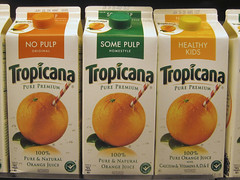美國哥倫比亞大學研究人員效法「臉書」工程師,發展出新的碳足跡計算軟體,可以同時計算數千種產品。目前計算碳足跡還是個花費許多時間和金錢的程序。
碳足跡可以預估一個活動對氣候改變的整體影響。一般來說,碳足跡除了藉由計算該活動預估排放的溫室氣體「二氧化碳」量,也會計算其他溫室氣體的排放,例如甲烷、一氧化氮或冷媒。這些效應加總後會以單一數字表達:「二氧化碳當量」,也就是造成相同暖化效應的二氧化碳量。
一個企業如果要想辦法管理和降低其活動對氣候的影響,獲得產品精確的碳足跡評估是非常關鍵的一步。
哥倫比亞大學地球研究所和哥倫比亞工程學的副研究員邁因倫肯(Christoph Meinrenken)表示,這個新軟體可以幫助公司精確標示產品,並設計降低對環境影響的方法。
這個計畫是地球所朗菲斯特永續能源中心和百事公司合作的成果。該計畫起始於2007年,一開始的目標是評估並協助百事公司標準化計算製造一個產品、包裝、配送和丟棄過程中,二氧化碳的釋放量。
 該計畫產生美國第一個由公正第三者認證碳足跡標誌的產品:純品康納(Tropicana )的柳橙汁。百事公司從2011年起,首先測試這個軟體的他種用途。
該計畫產生美國第一個由公正第三者認證碳足跡標誌的產品:純品康納(Tropicana )的柳橙汁。百事公司從2011年起,首先測試這個軟體的他種用途。
百事公司永續發展部門的資深主任哈爾沃森(Al Halvorsen)說:「新發展的軟體不只能節省(百事)公司的時間和金錢,也能提供公司未來如何測量、管理和降低碳足跡的新觀點。」
直到現在,生命周期評估(Life Cycle Assessment,LCA)還是一次只能評估一項產品,這個程序需要很多時間和許多具有特殊專長的人員,大部份公司都沒有這些資源。一個適切的分析需要蒐集數據和非常精細的計算。
邁因倫肯表示是臉書的資料探勘研究,激勵了他和團隊。
他說:「在臉書或電影租賃公司Netflix的公司裡,工程師利用統計方法挖掘並分析龐大的資料庫,基本上是教導電腦去預測,舉例來說,誰將會喜歡哪部電影。對環境工程師來說,利用數據預估環境會多『喜歡』某個產品和服務,特別有價值。」
有了這個概念,哥倫比亞大學的科學家設計出一個LCA分析資料庫,能評估百事公司裡1137種產品的環境影響力。
他們發展的技術可以在數分鐘內,計算數千種產品的碳足跡,同時也減低人工操作的時間。
軟體的關鍵是一個產生「物質預估釋放因子」的電腦模式,它可以減低對一個產品成份分析和整合的人工操作。
邁因倫肯表示,能自動產生數據讓非專家也能「計算約略的碳足跡,並減輕公司大規模計算產品碳足跡時的資源限制。」
他表示這個軟體根據非營利團體「世界資源研究所」(World Resources Institute)倡議的指導方針編輯,該研究所提供碳足跡稽查的標準。
如果公司有了碳足跡的資訊,就可以設計和評估減輕產品對環境影響的方式,而消費者也能在充分資訊下,做出更好的決定。
朗菲斯特永續能源中心的主任萊克納(Klaus Lackner)表示:「快速計算碳足跡是一個很棒的例子,代表學界的方法論和現代數據分析與統計工具,可以進入生活中,並且在現實世界中展現它們的力量。」
目前邁因倫肯和團隊正嘗試將這些方法應用在其他領域,例如水資源利用。
他們的研究發表在《工業生態學期刊》線上版。
Taking a page from Facebook engineers, researchers at Columbia University have developed new software that can calculate the carbon footprints of thousands of products simultaneously, a process that until now has been time consuming and expensive.
A carbon footprint is an estimate of an activity’s total impact on climate change. Typically, a carbon footprint is calculated by estimating not only the amount of the greenhouse gas carbon dioxide that the activity emits, but also emissions of other greenhouse gases such as methane, nitrous oxide or refrigerants. All these impacts are added up and expressed as a single number, a carbon dioxide equivalent – the amount of CO2 that would create the same amount of warming.
Getting an accurate carbon footprint for a product is a crucial first step for any company seeking to manage and reduce the climate change impact of its activities.
The new software can help companies accurately label products and design ways to reduce their environmental impacts, says Christoph Meinrenken, the project’s leader and associate research scientist at Columbia University’s Earth Institute and Columbia Engineering.
The project is the result of a collaboration between the institute’s Lenfest Center for Sustainable Energy and PepsiCo, Inc.
Started in 2007, the project’s original goal was to evaluate and help standardize PepsiCo’s calculations of the amount of carbon dioxide emitted when a product is made, packaged, distributed and disposed of.
The project yielded the first U.S. carbon footprint label certified by an impartial third party, for Tropicana orange juice. PepsiCo has been pilot testing the method for other uses since 2011.
Al Halvorsen, senior director of sustainability at PepsiCo, said, “The newly developed software promises to not only save time and money for companies like PepsiCo, but also to provide fresh insights into how companies measure, manage, and reduce their carbon footprint in the future.”
Until now, life cycle analysis has been performed one product at a time, a process that requires lots of time and large numbers of personnel with specialized expertise, which few companies have. Aggregating data and calculations misses the microscopic level of detail a proper analysis requires.
Meinrenken says he and his team were inspired by the work of Facebook data miners.
“At companies like Facebook or Netflix, engineers employ statistical wizardry to mine vast datasets and essentially teach computers to predict, for instance, who will like a particular movie. For an environmental engineer, using such data to estimate how much the environment will ‘like’ certain products and services is especially rewarding,” he said.
With this in mind, the Columbia scientists designed a life cycle analysis database to assess the environmental impact of 1,137 PepsiCo products.
They developed techniques that together enable the calculation of thousands of carbon footprints within minutes, with minimal user input.
The key component is a computer model that generates estimated emission factors for materials, eliminating manual mapping of a product’s ingredients and packaging materials.
Meinrenken said the automatically generated data enable non-experts “to calculate approximate carbon footprints and alleviate resource constraints for companies embarking on large-scale product carbon footprinting.”
He said the software complies with guidelines sponsored by the nonprofit World Resources Institute, which provides standards against which carbon footprints can be audited.
With this carbon footprint information, companies can design and assess ways to lessen the environmental impacts of their products and consumers will be able to make better informed choices.
“Fast carbon footprinting is a great example of how academic methodologies with modern data processing and statistical tools can be brought to life and unlock their power in the real world,” said Klaus Lackner, director of the Lenfest Center for Sustainable Energy.
Meinrenken and his team are now looking at applying these methods to other areas, such as water use.
Their study is published online in the “Journal of Industrial Ecology.”
※ 全文及圖片詳見:ENS







